Concrete Testing: Slump, Compressive, Tensile, and Flexural Tests
VerifiedAdded on 2022/08/23
|19
|2655
|15
Report
AI Summary
This report provides a comprehensive analysis of concrete testing procedures and results. It details the methods used to determine concrete properties, including the slump test for workability and tests for compressive, tensile, and flexural strengths to assess structural integrity. The report outlines the experimental procedures, mix proportions, and the relationship between water-cement ratio and various concrete strengths. Results are presented in tables and graphs, showing the correlation between water content, density, and the different strength parameters. The discussion section explains the observed trends, emphasizing the critical role of the water-cement ratio in influencing concrete durability, porosity, and overall performance. The analysis highlights the inverse relationship between water-cement ratio and compressive, tensile, and flexural strengths, illustrating the importance of proper mix design in achieving desired concrete properties. The report concludes by summarizing the key findings and their implications for concrete technology and construction practices.
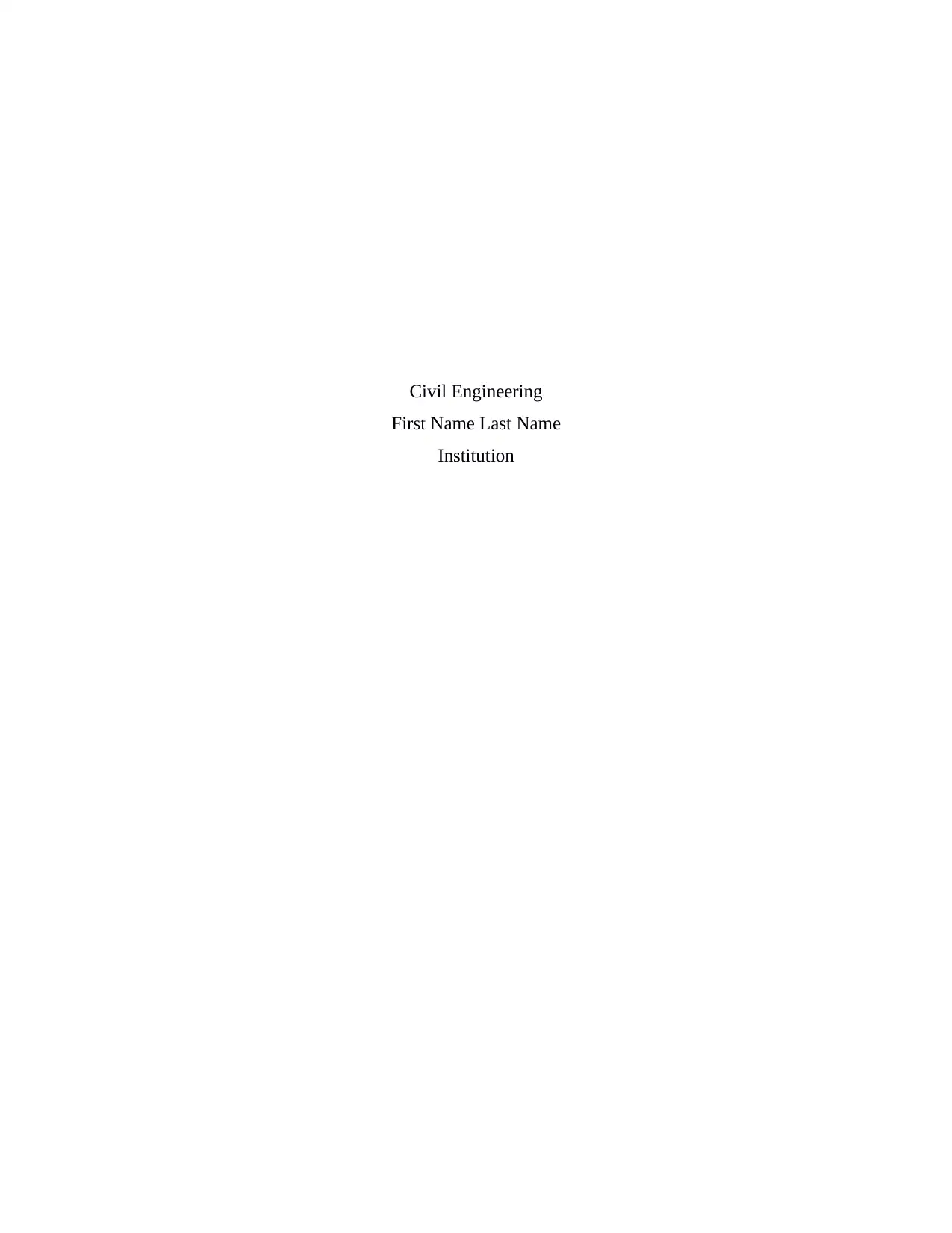
Civil Engineering
First Name Last Name
Institution
First Name Last Name
Institution
Paraphrase This Document
Need a fresh take? Get an instant paraphrase of this document with our AI Paraphraser
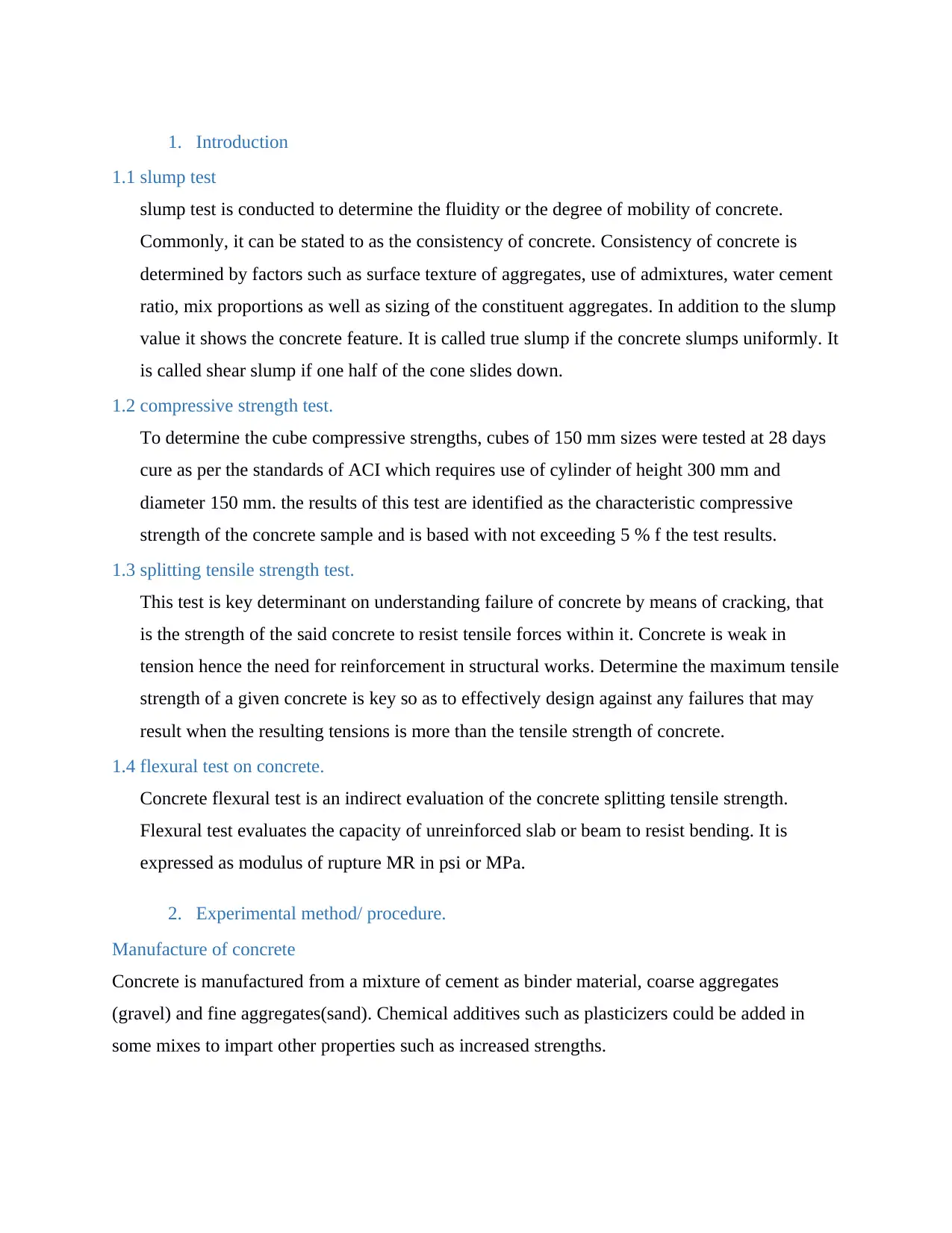
1. Introduction
1.1 slump test
slump test is conducted to determine the fluidity or the degree of mobility of concrete.
Commonly, it can be stated to as the consistency of concrete. Consistency of concrete is
determined by factors such as surface texture of aggregates, use of admixtures, water cement
ratio, mix proportions as well as sizing of the constituent aggregates. In addition to the slump
value it shows the concrete feature. It is called true slump if the concrete slumps uniformly. It
is called shear slump if one half of the cone slides down.
1.2 compressive strength test.
To determine the cube compressive strengths, cubes of 150 mm sizes were tested at 28 days
cure as per the standards of ACI which requires use of cylinder of height 300 mm and
diameter 150 mm. the results of this test are identified as the characteristic compressive
strength of the concrete sample and is based with not exceeding 5 % f the test results.
1.3 splitting tensile strength test.
This test is key determinant on understanding failure of concrete by means of cracking, that
is the strength of the said concrete to resist tensile forces within it. Concrete is weak in
tension hence the need for reinforcement in structural works. Determine the maximum tensile
strength of a given concrete is key so as to effectively design against any failures that may
result when the resulting tensions is more than the tensile strength of concrete.
1.4 flexural test on concrete.
Concrete flexural test is an indirect evaluation of the concrete splitting tensile strength.
Flexural test evaluates the capacity of unreinforced slab or beam to resist bending. It is
expressed as modulus of rupture MR in psi or MPa.
2. Experimental method/ procedure.
Manufacture of concrete
Concrete is manufactured from a mixture of cement as binder material, coarse aggregates
(gravel) and fine aggregates(sand). Chemical additives such as plasticizers could be added in
some mixes to impart other properties such as increased strengths.
1.1 slump test
slump test is conducted to determine the fluidity or the degree of mobility of concrete.
Commonly, it can be stated to as the consistency of concrete. Consistency of concrete is
determined by factors such as surface texture of aggregates, use of admixtures, water cement
ratio, mix proportions as well as sizing of the constituent aggregates. In addition to the slump
value it shows the concrete feature. It is called true slump if the concrete slumps uniformly. It
is called shear slump if one half of the cone slides down.
1.2 compressive strength test.
To determine the cube compressive strengths, cubes of 150 mm sizes were tested at 28 days
cure as per the standards of ACI which requires use of cylinder of height 300 mm and
diameter 150 mm. the results of this test are identified as the characteristic compressive
strength of the concrete sample and is based with not exceeding 5 % f the test results.
1.3 splitting tensile strength test.
This test is key determinant on understanding failure of concrete by means of cracking, that
is the strength of the said concrete to resist tensile forces within it. Concrete is weak in
tension hence the need for reinforcement in structural works. Determine the maximum tensile
strength of a given concrete is key so as to effectively design against any failures that may
result when the resulting tensions is more than the tensile strength of concrete.
1.4 flexural test on concrete.
Concrete flexural test is an indirect evaluation of the concrete splitting tensile strength.
Flexural test evaluates the capacity of unreinforced slab or beam to resist bending. It is
expressed as modulus of rupture MR in psi or MPa.
2. Experimental method/ procedure.
Manufacture of concrete
Concrete is manufactured from a mixture of cement as binder material, coarse aggregates
(gravel) and fine aggregates(sand). Chemical additives such as plasticizers could be added in
some mixes to impart other properties such as increased strengths.
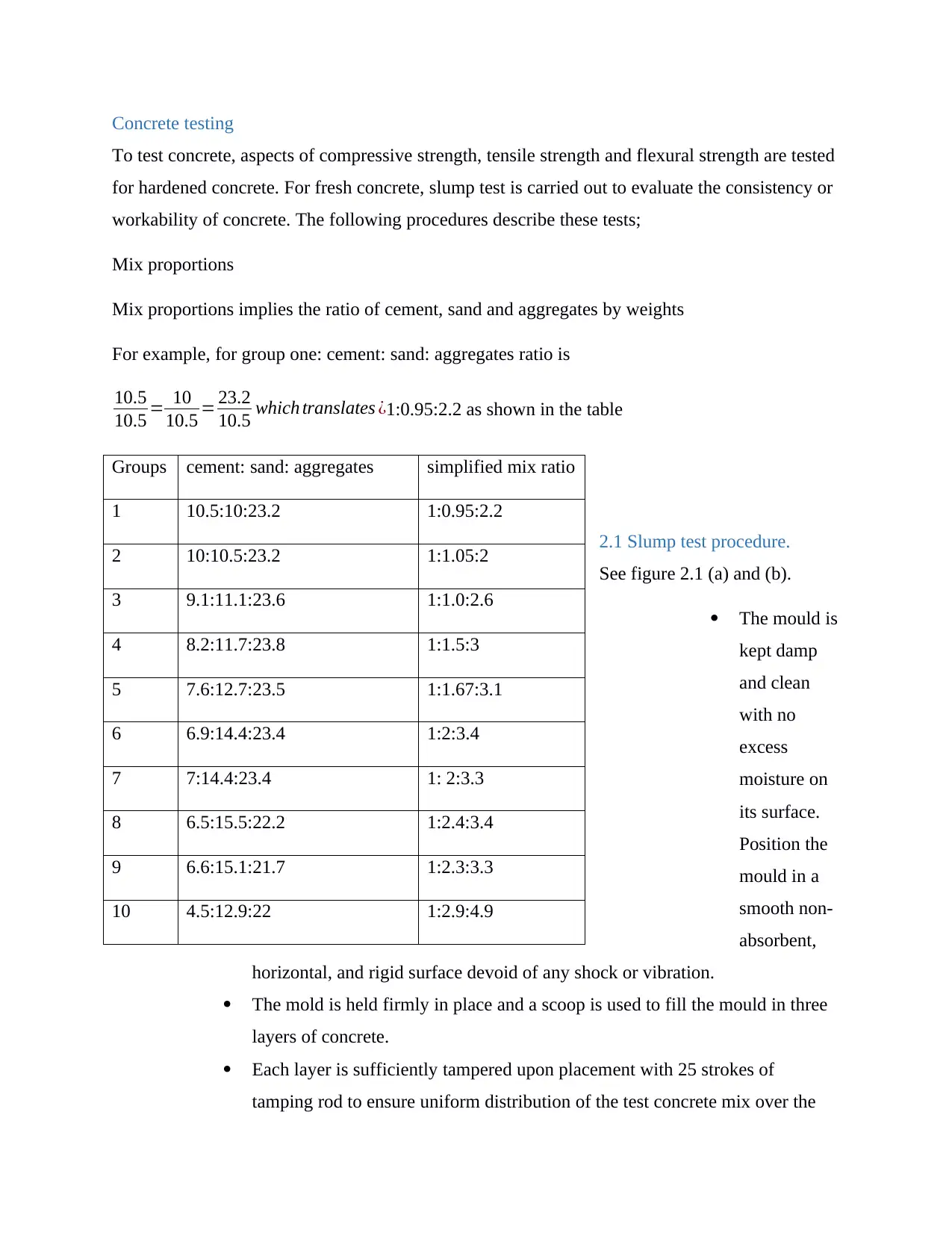
Concrete testing
To test concrete, aspects of compressive strength, tensile strength and flexural strength are tested
for hardened concrete. For fresh concrete, slump test is carried out to evaluate the consistency or
workability of concrete. The following procedures describe these tests;
Mix proportions
Mix proportions implies the ratio of cement, sand and aggregates by weights
For example, for group one: cement: sand: aggregates ratio is
10.5
10.5 = 10
10.5 = 23.2
10.5 which translates ¿1:0.95:2.2 as shown in the table
2.1 Slump test procedure.
See figure 2.1 (a) and (b).
The mould is
kept damp
and clean
with no
excess
moisture on
its surface.
Position the
mould in a
smooth non-
absorbent,
horizontal, and rigid surface devoid of any shock or vibration.
The mold is held firmly in place and a scoop is used to fill the mould in three
layers of concrete.
Each layer is sufficiently tampered upon placement with 25 strokes of
tamping rod to ensure uniform distribution of the test concrete mix over the
Groups cement: sand: aggregates simplified mix ratio
1 10.5:10:23.2 1:0.95:2.2
2 10:10.5:23.2 1:1.05:2
3 9.1:11.1:23.6 1:1.0:2.6
4 8.2:11.7:23.8 1:1.5:3
5 7.6:12.7:23.5 1:1.67:3.1
6 6.9:14.4:23.4 1:2:3.4
7 7:14.4:23.4 1: 2:3.3
8 6.5:15.5:22.2 1:2.4:3.4
9 6.6:15.1:21.7 1:2.3:3.3
10 4.5:12.9:22 1:2.9:4.9
To test concrete, aspects of compressive strength, tensile strength and flexural strength are tested
for hardened concrete. For fresh concrete, slump test is carried out to evaluate the consistency or
workability of concrete. The following procedures describe these tests;
Mix proportions
Mix proportions implies the ratio of cement, sand and aggregates by weights
For example, for group one: cement: sand: aggregates ratio is
10.5
10.5 = 10
10.5 = 23.2
10.5 which translates ¿1:0.95:2.2 as shown in the table
2.1 Slump test procedure.
See figure 2.1 (a) and (b).
The mould is
kept damp
and clean
with no
excess
moisture on
its surface.
Position the
mould in a
smooth non-
absorbent,
horizontal, and rigid surface devoid of any shock or vibration.
The mold is held firmly in place and a scoop is used to fill the mould in three
layers of concrete.
Each layer is sufficiently tampered upon placement with 25 strokes of
tamping rod to ensure uniform distribution of the test concrete mix over the
Groups cement: sand: aggregates simplified mix ratio
1 10.5:10:23.2 1:0.95:2.2
2 10:10.5:23.2 1:1.05:2
3 9.1:11.1:23.6 1:1.0:2.6
4 8.2:11.7:23.8 1:1.5:3
5 7.6:12.7:23.5 1:1.67:3.1
6 6.9:14.4:23.4 1:2:3.4
7 7:14.4:23.4 1: 2:3.3
8 6.5:15.5:22.2 1:2.4:3.4
9 6.6:15.1:21.7 1:2.3:3.3
10 4.5:12.9:22 1:2.9:4.9
⊘ This is a preview!⊘
Do you want full access?
Subscribe today to unlock all pages.

Trusted by 1+ million students worldwide
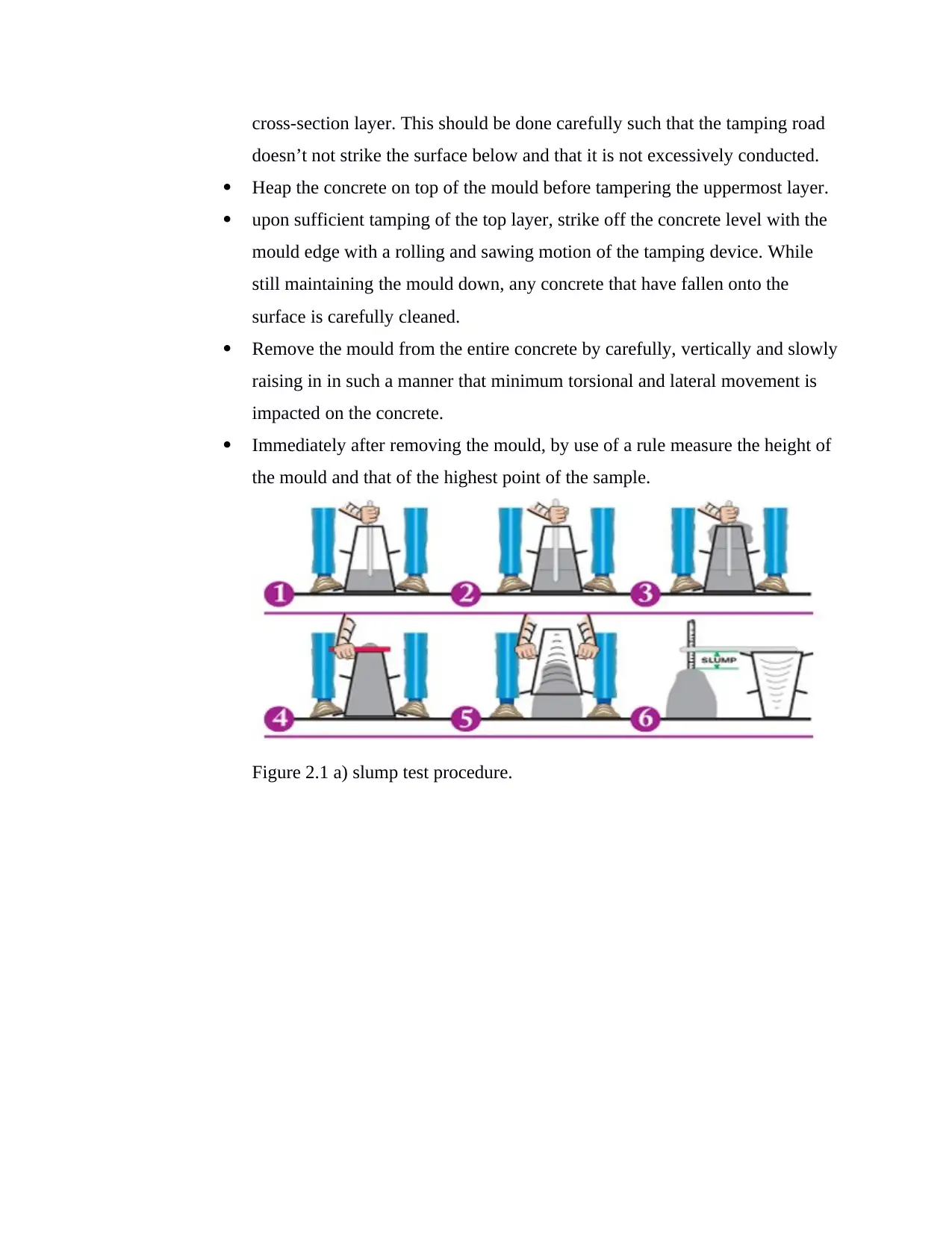
cross-section layer. This should be done carefully such that the tamping road
doesn’t not strike the surface below and that it is not excessively conducted.
Heap the concrete on top of the mould before tampering the uppermost layer.
upon sufficient tamping of the top layer, strike off the concrete level with the
mould edge with a rolling and sawing motion of the tamping device. While
still maintaining the mould down, any concrete that have fallen onto the
surface is carefully cleaned.
Remove the mould from the entire concrete by carefully, vertically and slowly
raising in in such a manner that minimum torsional and lateral movement is
impacted on the concrete.
Immediately after removing the mould, by use of a rule measure the height of
the mould and that of the highest point of the sample.
Figure 2.1 a) slump test procedure.
doesn’t not strike the surface below and that it is not excessively conducted.
Heap the concrete on top of the mould before tampering the uppermost layer.
upon sufficient tamping of the top layer, strike off the concrete level with the
mould edge with a rolling and sawing motion of the tamping device. While
still maintaining the mould down, any concrete that have fallen onto the
surface is carefully cleaned.
Remove the mould from the entire concrete by carefully, vertically and slowly
raising in in such a manner that minimum torsional and lateral movement is
impacted on the concrete.
Immediately after removing the mould, by use of a rule measure the height of
the mould and that of the highest point of the sample.
Figure 2.1 a) slump test procedure.
Paraphrase This Document
Need a fresh take? Get an instant paraphrase of this document with our AI Paraphraser
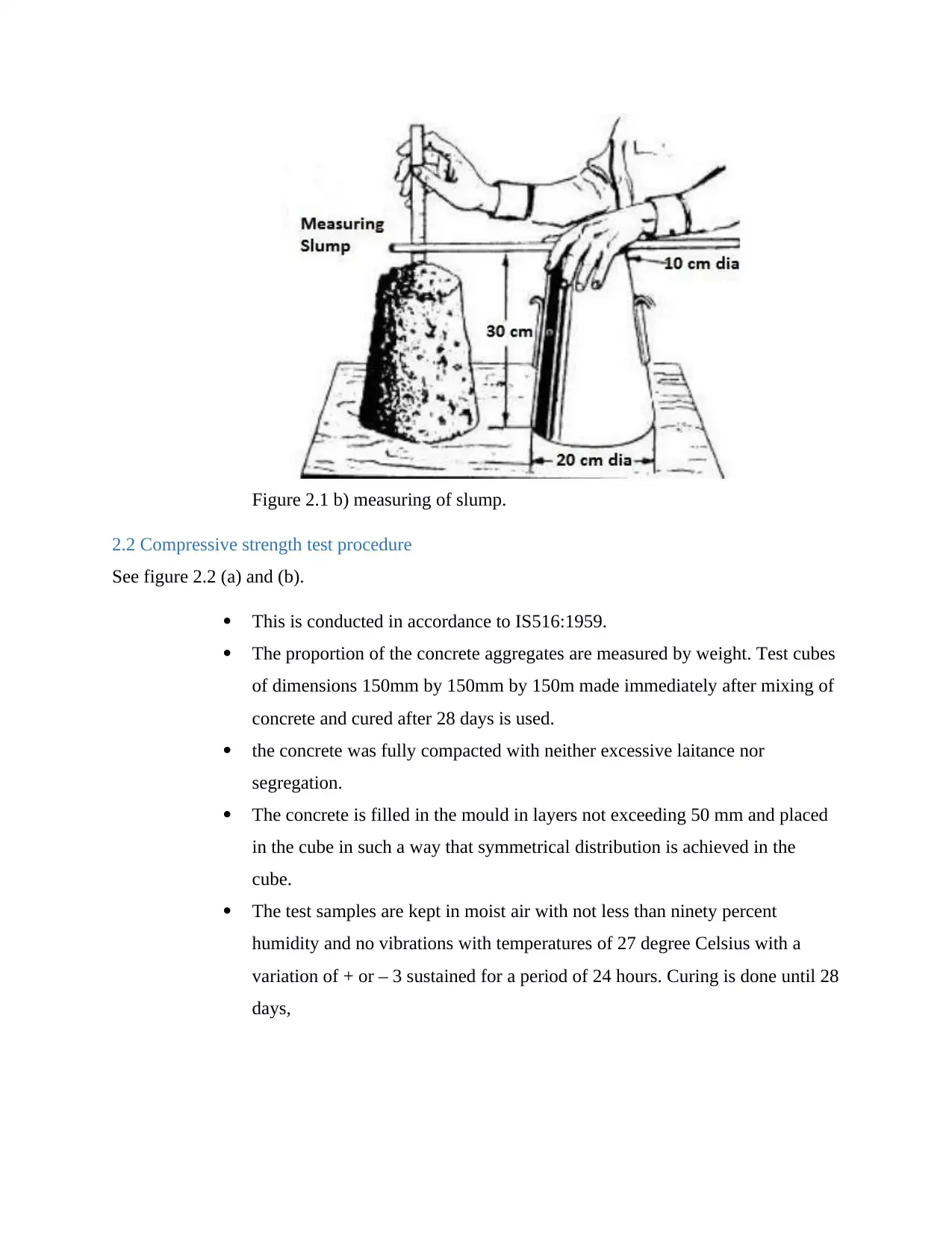
Figure 2.1 b) measuring of slump.
2.2 Compressive strength test procedure
See figure 2.2 (a) and (b).
This is conducted in accordance to IS516:1959.
The proportion of the concrete aggregates are measured by weight. Test cubes
of dimensions 150mm by 150mm by 150m made immediately after mixing of
concrete and cured after 28 days is used.
the concrete was fully compacted with neither excessive laitance nor
segregation.
The concrete is filled in the mould in layers not exceeding 50 mm and placed
in the cube in such a way that symmetrical distribution is achieved in the
cube.
The test samples are kept in moist air with not less than ninety percent
humidity and no vibrations with temperatures of 27 degree Celsius with a
variation of + or – 3 sustained for a period of 24 hours. Curing is done until 28
days,
2.2 Compressive strength test procedure
See figure 2.2 (a) and (b).
This is conducted in accordance to IS516:1959.
The proportion of the concrete aggregates are measured by weight. Test cubes
of dimensions 150mm by 150mm by 150m made immediately after mixing of
concrete and cured after 28 days is used.
the concrete was fully compacted with neither excessive laitance nor
segregation.
The concrete is filled in the mould in layers not exceeding 50 mm and placed
in the cube in such a way that symmetrical distribution is achieved in the
cube.
The test samples are kept in moist air with not less than ninety percent
humidity and no vibrations with temperatures of 27 degree Celsius with a
variation of + or – 3 sustained for a period of 24 hours. Curing is done until 28
days,
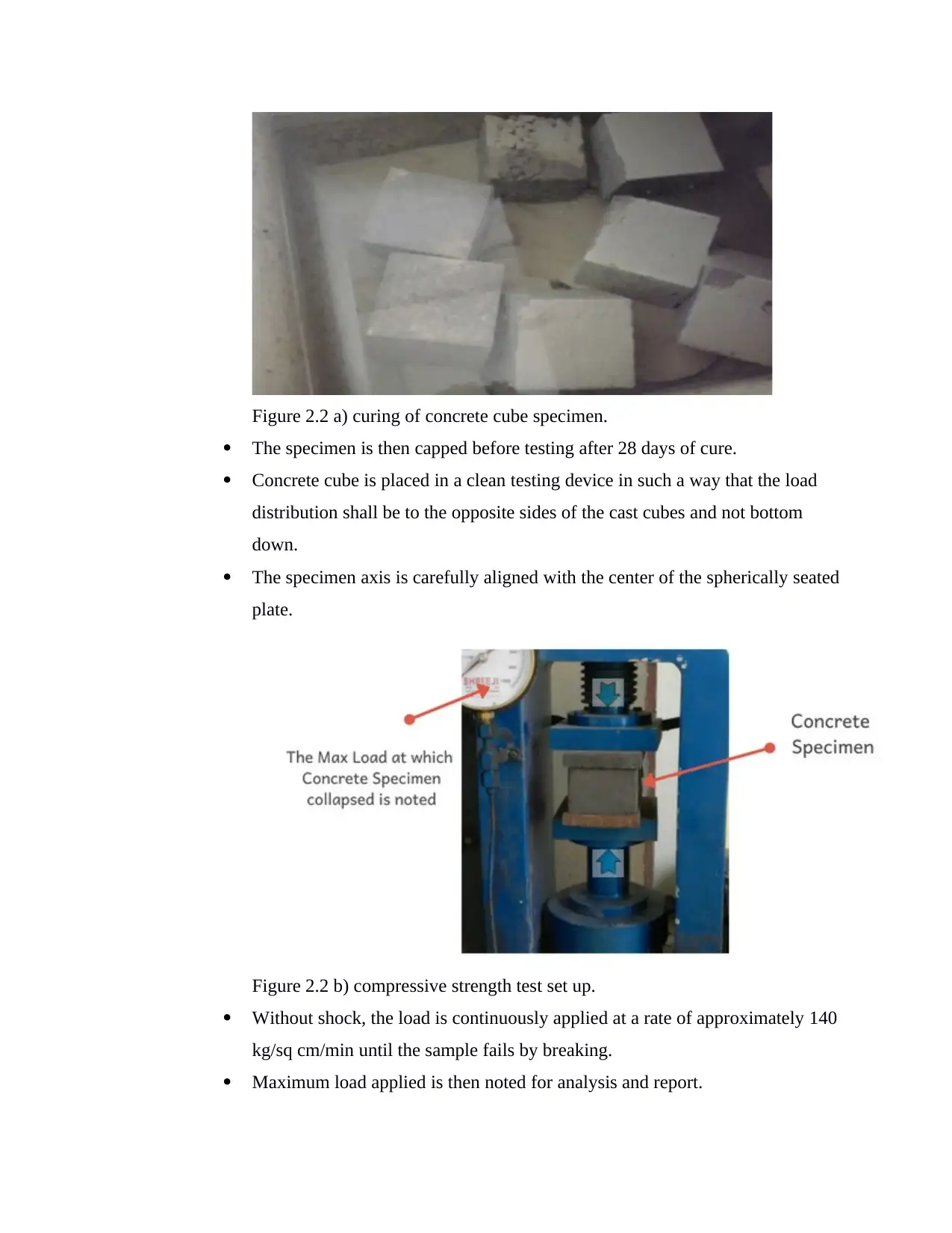
Figure 2.2 a) curing of concrete cube specimen.
The specimen is then capped before testing after 28 days of cure.
Concrete cube is placed in a clean testing device in such a way that the load
distribution shall be to the opposite sides of the cast cubes and not bottom
down.
The specimen axis is carefully aligned with the center of the spherically seated
plate.
Figure 2.2 b) compressive strength test set up.
Without shock, the load is continuously applied at a rate of approximately 140
kg/sq cm/min until the sample fails by breaking.
Maximum load applied is then noted for analysis and report.
The specimen is then capped before testing after 28 days of cure.
Concrete cube is placed in a clean testing device in such a way that the load
distribution shall be to the opposite sides of the cast cubes and not bottom
down.
The specimen axis is carefully aligned with the center of the spherically seated
plate.
Figure 2.2 b) compressive strength test set up.
Without shock, the load is continuously applied at a rate of approximately 140
kg/sq cm/min until the sample fails by breaking.
Maximum load applied is then noted for analysis and report.
⊘ This is a preview!⊘
Do you want full access?
Subscribe today to unlock all pages.

Trusted by 1+ million students worldwide
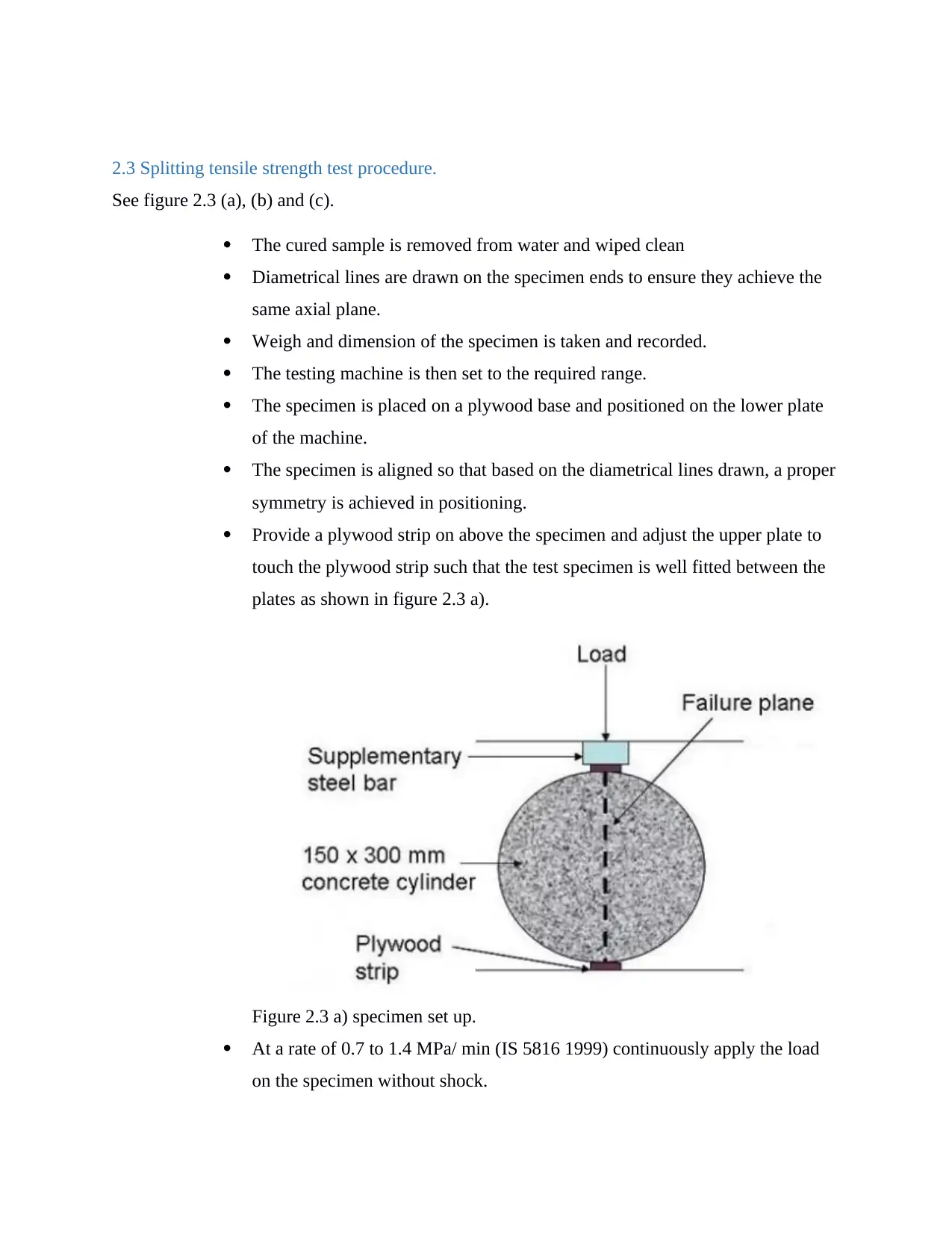
2.3 Splitting tensile strength test procedure.
See figure 2.3 (a), (b) and (c).
The cured sample is removed from water and wiped clean
Diametrical lines are drawn on the specimen ends to ensure they achieve the
same axial plane.
Weigh and dimension of the specimen is taken and recorded.
The testing machine is then set to the required range.
The specimen is placed on a plywood base and positioned on the lower plate
of the machine.
The specimen is aligned so that based on the diametrical lines drawn, a proper
symmetry is achieved in positioning.
Provide a plywood strip on above the specimen and adjust the upper plate to
touch the plywood strip such that the test specimen is well fitted between the
plates as shown in figure 2.3 a).
Figure 2.3 a) specimen set up.
At a rate of 0.7 to 1.4 MPa/ min (IS 5816 1999) continuously apply the load
on the specimen without shock.
See figure 2.3 (a), (b) and (c).
The cured sample is removed from water and wiped clean
Diametrical lines are drawn on the specimen ends to ensure they achieve the
same axial plane.
Weigh and dimension of the specimen is taken and recorded.
The testing machine is then set to the required range.
The specimen is placed on a plywood base and positioned on the lower plate
of the machine.
The specimen is aligned so that based on the diametrical lines drawn, a proper
symmetry is achieved in positioning.
Provide a plywood strip on above the specimen and adjust the upper plate to
touch the plywood strip such that the test specimen is well fitted between the
plates as shown in figure 2.3 a).
Figure 2.3 a) specimen set up.
At a rate of 0.7 to 1.4 MPa/ min (IS 5816 1999) continuously apply the load
on the specimen without shock.
Paraphrase This Document
Need a fresh take? Get an instant paraphrase of this document with our AI Paraphraser
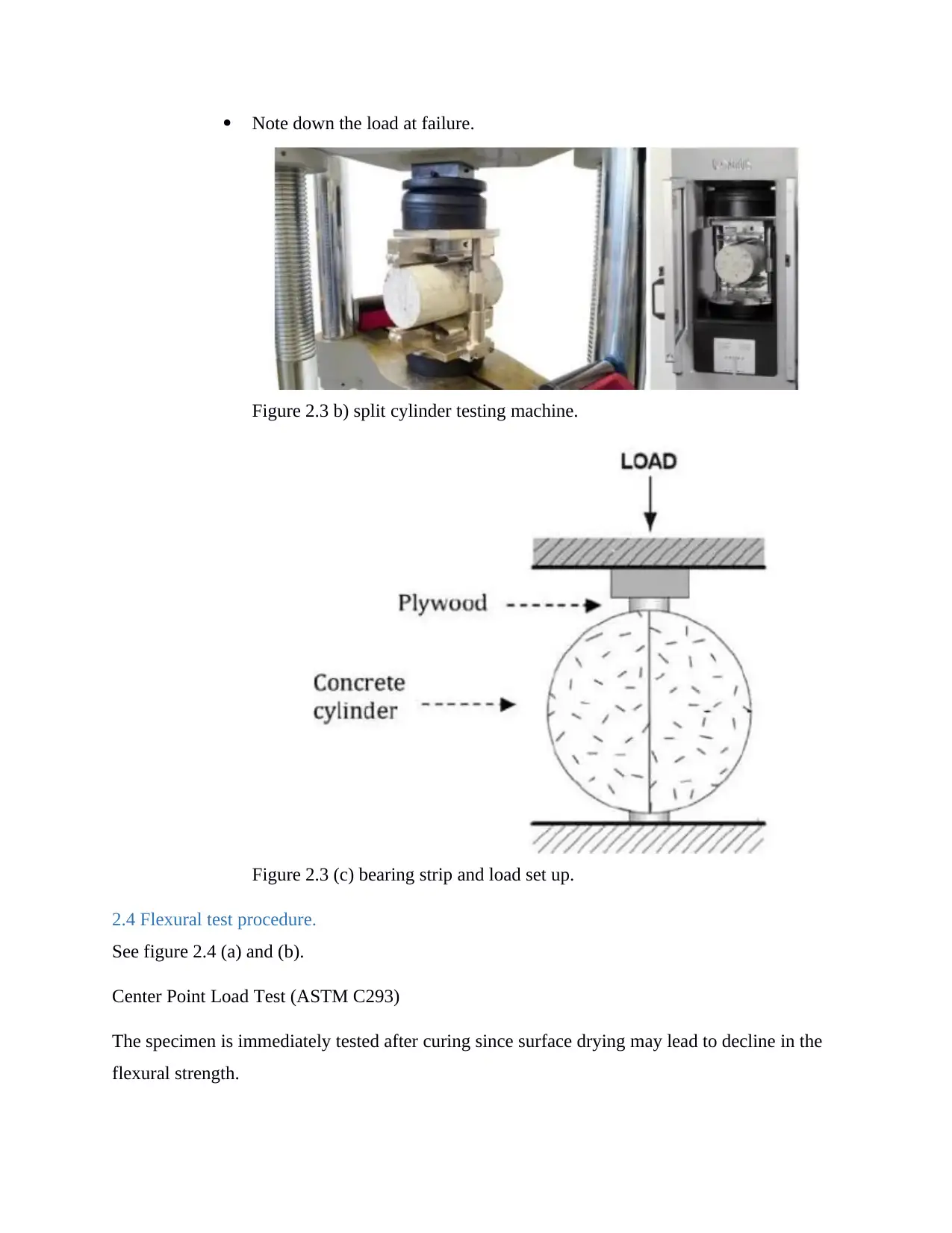
Note down the load at failure.
Figure 2.3 b) split cylinder testing machine.
Figure 2.3 (c) bearing strip and load set up.
2.4 Flexural test procedure.
See figure 2.4 (a) and (b).
Center Point Load Test (ASTM C293)
The specimen is immediately tested after curing since surface drying may lead to decline in the
flexural strength.
Figure 2.3 b) split cylinder testing machine.
Figure 2.3 (c) bearing strip and load set up.
2.4 Flexural test procedure.
See figure 2.4 (a) and (b).
Center Point Load Test (ASTM C293)
The specimen is immediately tested after curing since surface drying may lead to decline in the
flexural strength.
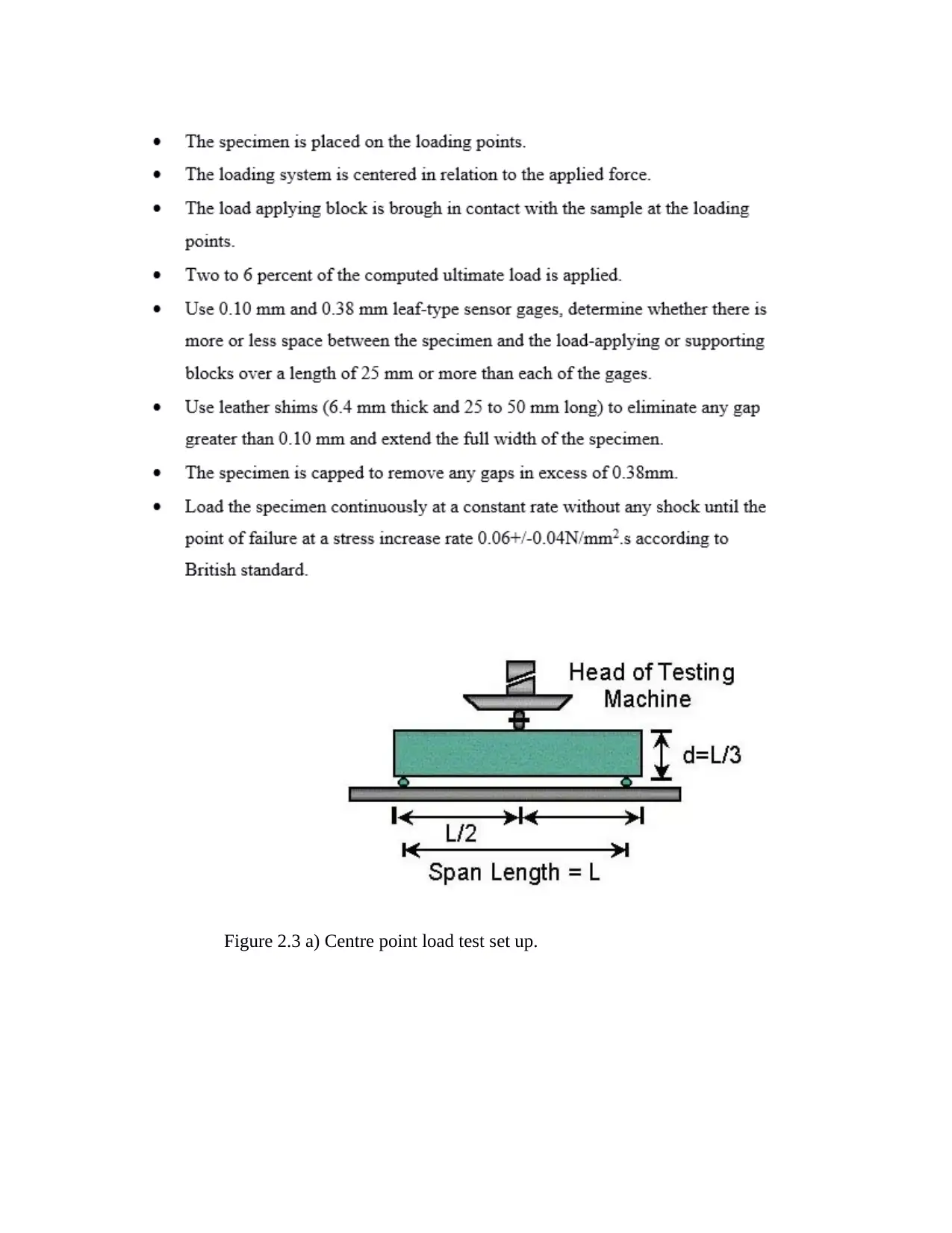
Figure 2.3 a) Centre point load test set up.
⊘ This is a preview!⊘
Do you want full access?
Subscribe today to unlock all pages.

Trusted by 1+ million students worldwide
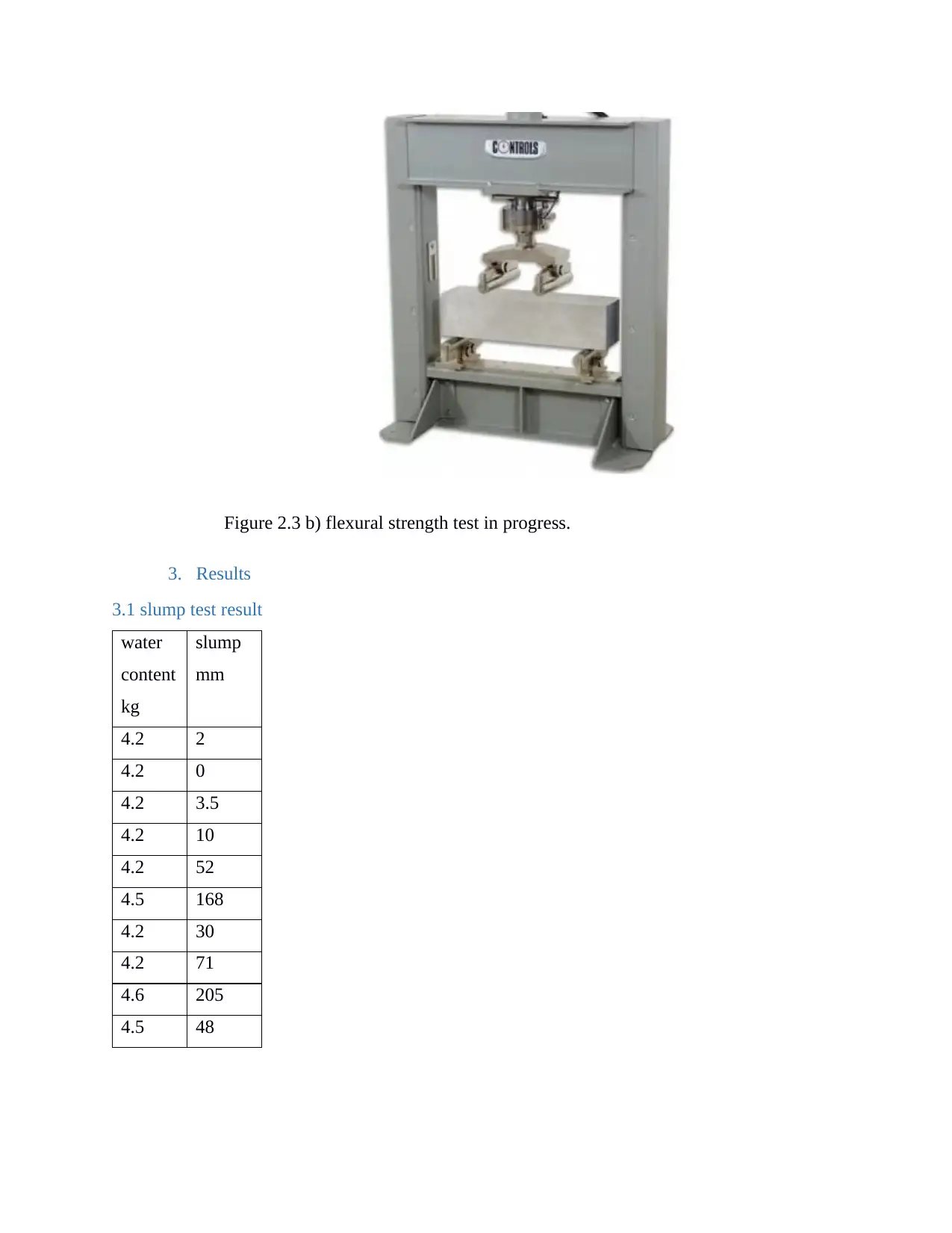
Figure 2.3 b) flexural strength test in progress.
3. Results
3.1 slump test result
water
content
kg
slump
mm
4.2 2
4.2 0
4.2 3.5
4.2 10
4.2 52
4.5 168
4.2 30
4.2 71
4.6 205
4.5 48
3. Results
3.1 slump test result
water
content
kg
slump
mm
4.2 2
4.2 0
4.2 3.5
4.2 10
4.2 52
4.5 168
4.2 30
4.2 71
4.6 205
4.5 48
Paraphrase This Document
Need a fresh take? Get an instant paraphrase of this document with our AI Paraphraser
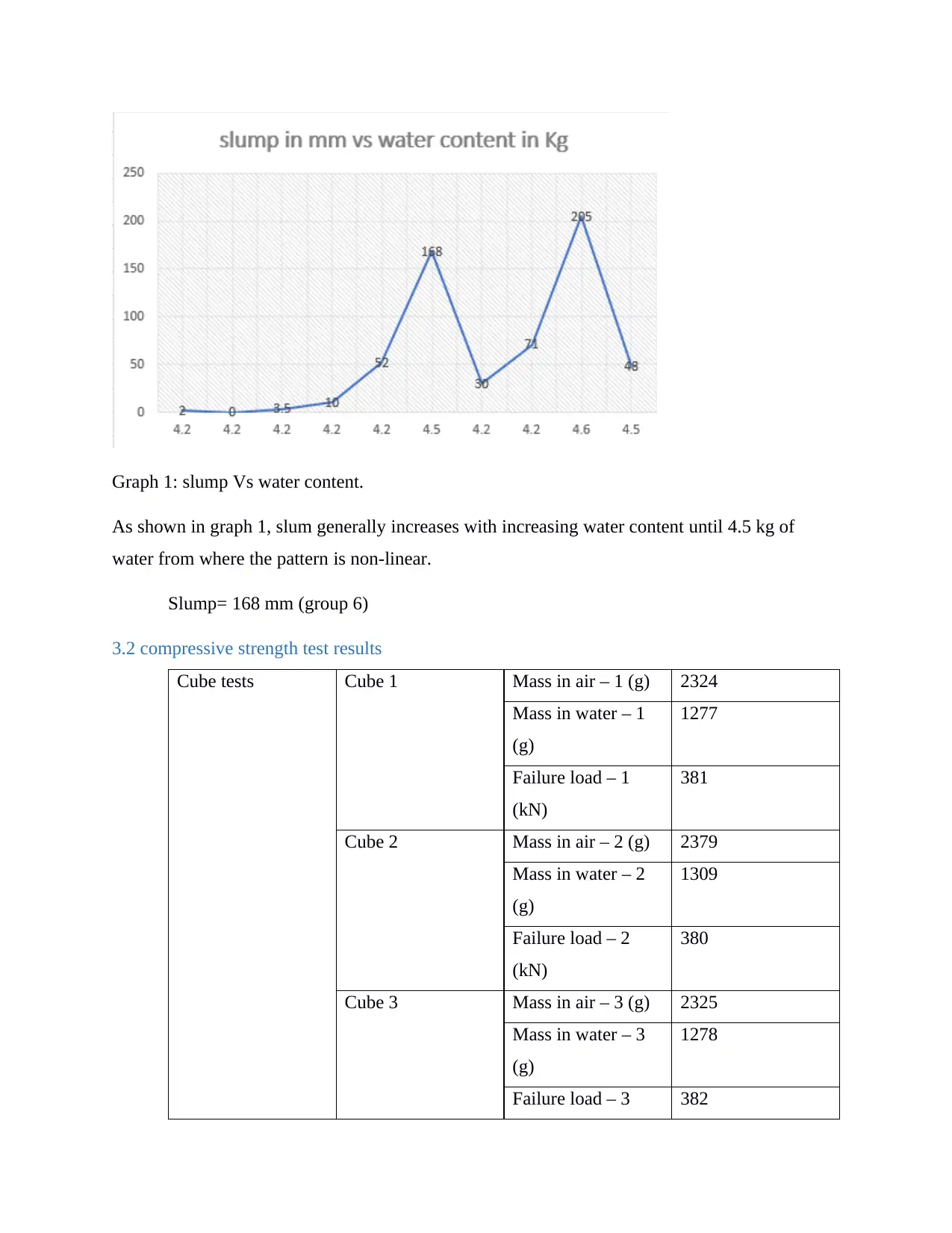
Graph 1: slump Vs water content.
As shown in graph 1, slum generally increases with increasing water content until 4.5 kg of
water from where the pattern is non-linear.
Slump= 168 mm (group 6)
3.2 compressive strength test results
Cube tests Cube 1 Mass in air – 1 (g) 2324
Mass in water – 1
(g)
1277
Failure load – 1
(kN)
381
Cube 2 Mass in air – 2 (g) 2379
Mass in water – 2
(g)
1309
Failure load – 2
(kN)
380
Cube 3 Mass in air – 3 (g) 2325
Mass in water – 3
(g)
1278
Failure load – 3 382
As shown in graph 1, slum generally increases with increasing water content until 4.5 kg of
water from where the pattern is non-linear.
Slump= 168 mm (group 6)
3.2 compressive strength test results
Cube tests Cube 1 Mass in air – 1 (g) 2324
Mass in water – 1
(g)
1277
Failure load – 1
(kN)
381
Cube 2 Mass in air – 2 (g) 2379
Mass in water – 2
(g)
1309
Failure load – 2
(kN)
380
Cube 3 Mass in air – 3 (g) 2325
Mass in water – 3
(g)
1278
Failure load – 3 382
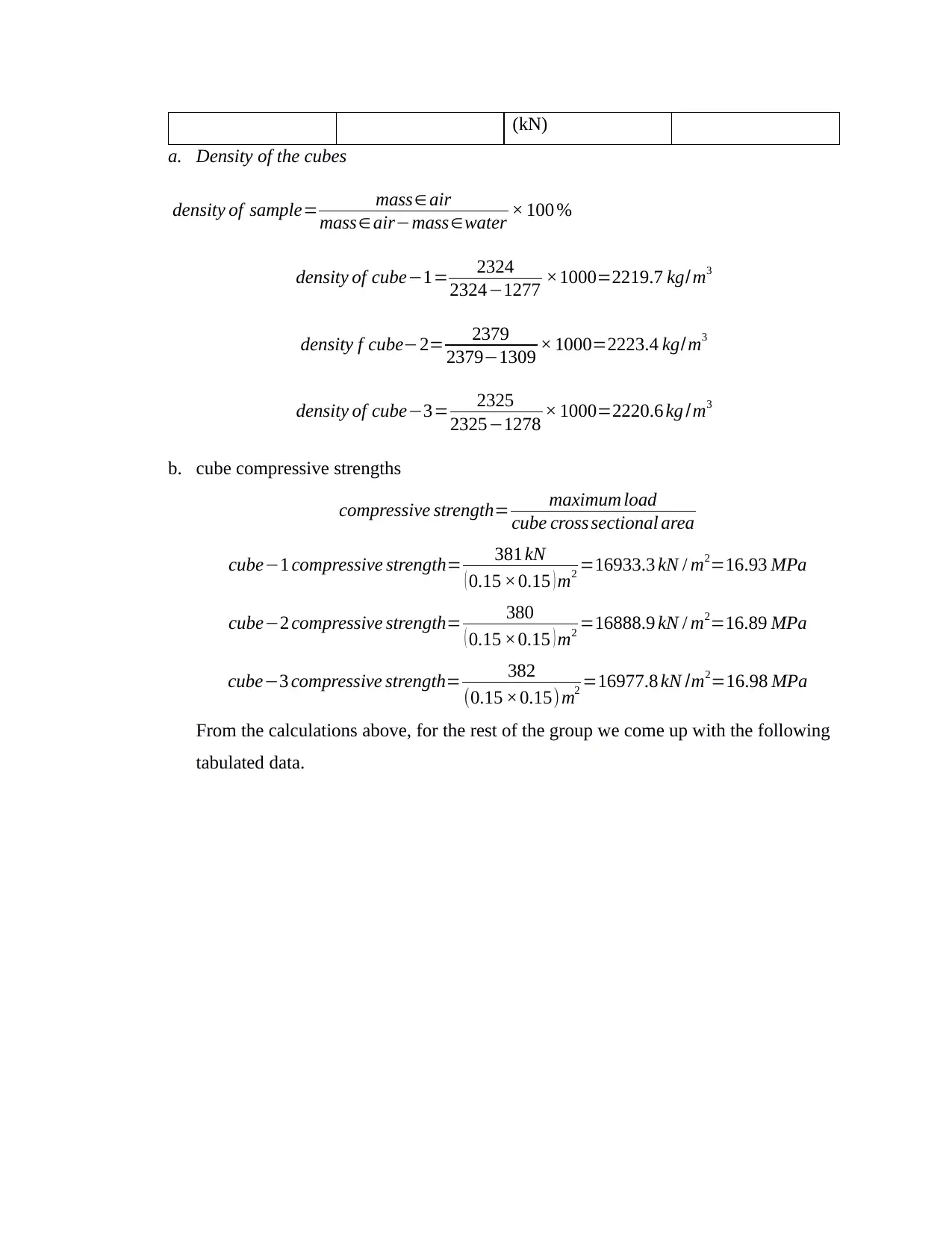
(kN)
a. Density of the cubes
density of sample= mass∈ air
mass∈air−mass∈water × 100 %
density of cube−1= 2324
2324−1277 ×1000=2219.7 kg/m3
density f cube−2= 2379
2379−1309 × 1000=2223.4 kg/m3
density of cube−3= 2325
2325−1278 × 1000=2220.6 kg /m3
b. cube compressive strengths
compressive strength= maximum load
cube cross sectional area
cube−1 compressive strength= 381 kN
( 0.15 ×0.15 ) m2 =16933.3 kN / m2=16.93 MPa
cube−2 compressive strength= 380
( 0.15 ×0.15 ) m2 =16888.9 kN / m2=16.89 MPa
cube−3 compressive strength= 382
(0.15 ×0.15)m2 =16977.8 kN /m2=16.98 MPa
From the calculations above, for the rest of the group we come up with the following
tabulated data.
a. Density of the cubes
density of sample= mass∈ air
mass∈air−mass∈water × 100 %
density of cube−1= 2324
2324−1277 ×1000=2219.7 kg/m3
density f cube−2= 2379
2379−1309 × 1000=2223.4 kg/m3
density of cube−3= 2325
2325−1278 × 1000=2220.6 kg /m3
b. cube compressive strengths
compressive strength= maximum load
cube cross sectional area
cube−1 compressive strength= 381 kN
( 0.15 ×0.15 ) m2 =16933.3 kN / m2=16.93 MPa
cube−2 compressive strength= 380
( 0.15 ×0.15 ) m2 =16888.9 kN / m2=16.89 MPa
cube−3 compressive strength= 382
(0.15 ×0.15)m2 =16977.8 kN /m2=16.98 MPa
From the calculations above, for the rest of the group we come up with the following
tabulated data.
⊘ This is a preview!⊘
Do you want full access?
Subscribe today to unlock all pages.

Trusted by 1+ million students worldwide
1 out of 19
Related Documents
Your All-in-One AI-Powered Toolkit for Academic Success.
+13062052269
info@desklib.com
Available 24*7 on WhatsApp / Email
![[object Object]](/_next/static/media/star-bottom.7253800d.svg)
Unlock your academic potential
Copyright © 2020–2025 A2Z Services. All Rights Reserved. Developed and managed by ZUCOL.



